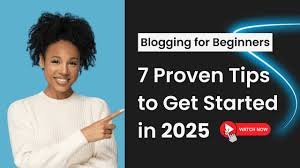How to Optimize Your Blog for SEO and Boost Organic Traffic
If you’ve just started blogging, or if you’ve been blogging for a while without seeing much organic traffic, it’s time to focus on SEO (Search Engine Optimization). SEO is one of the most effective ways to increase your blog’s visibility and attract more visitors without having to spend money on ads. Optimizing your blog for SEO ensures that your content appears in search engine results, allowing you to reach a wider audience.
In this post, we’ll explore the basics of SEO for bloggers and share actionable strategies to help you optimize your blog, improve your rankings, and ultimately drive more organic traffic to your website.
1. Understand the Importance of SEO for Bloggers
Before diving into specific tactics, it’s important to understand why SEO is crucial for your blog’s success. Simply put, SEO helps search engines (like Google) understand what your content is about and how relevant it is to a user’s search query. When done correctly, SEO can:
- Increase your visibility in search engine results pages (SERPs)
- Attract targeted traffic from users searching for topics related to your blog
- Boost your rankings over time with consistent SEO efforts
- Build credibility and authority within your niche
Without SEO, your blog’s content might remain buried deep in search results, where no one will see it. Optimizing your blog for SEO helps your content stand out and increases the chances of being discovered by new readers.

2. Keyword Research: The Foundation of SEO
The first step in optimizing your blog for SEO is conducting thorough keyword research. Keywords are the search terms or phrases that users type into search engines when looking for information. By identifying the right keywords for your blog, you can ensure that your content aligns with what people are actually searching for.
How to Conduct Keyword Research:
- Use keyword research tools: Tools like Google Keyword Planner, Ahrefs, and Ubersuggest can help you identify popular keywords in your niche.
- Focus on long-tail keywords: Long-tail keywords (longer, more specific phrases) tend to be less competitive and more targeted. For example, instead of targeting “blogging tips,” consider using “beginner blogging tips for 2025.”
- Analyze search intent: Think about the intent behind a search query. Are users looking for information, products, services, or solutions? Understanding search intent will help you create content that satisfies the needs of your audience.
- Check competitor content: Review the top-ranking blogs in your niche and analyze the keywords they’re targeting. This can give you ideas for topics and help you discover keyword gaps.
Once you’ve identified your target keywords, you can naturally incorporate them into your blog posts, headlines, meta descriptions, and other on-page elements to improve your SEO.
3. Optimize Your Blog Posts for On-Page SEO
On-page SEO refers to optimizing the elements within your blog post to make it more search engine-friendly. This includes optimizing your content, images, and HTML elements.
Here are some key on-page SEO factors to focus on:
1. Title Tags and Meta Descriptions:
- Title tags are what appear in search engine results as the clickable title of your post. Include your target keyword near the beginning of the title for best results.
- Meta descriptions provide a brief summary of your blog post and appear below the title in search results. A compelling meta description can increase your click-through rate (CTR). Make sure to include your target keyword and make it enticing for readers.
2. Headings and Subheadings:
- Use H1 tags for your main title and H2 or H3 tags for subheadings. This helps search engines understand the structure of your content and makes it easier for readers to skim your post.
- Incorporate relevant keywords in your headings, but make sure it’s natural and not forced.
3. Keyword Optimization:
- Keyword placement is crucial for SEO. Include your target keyword in the first 100 words of your post, and make sure it appears in a few headings and throughout the content. However, avoid keyword stuffing, as it can negatively impact readability and SEO.
- Include LSI (Latent Semantic Indexing) keywords: These are related terms that search engines use to understand the context of your content. For example, if your target keyword is “blogging for beginners,” related keywords could include “starting a blog,” “blogging tips,” or “how to make money blogging.”
4. Image Optimization:
- Use alt text to describe your images. This not only helps search engines understand the image content but also makes your blog more accessible to visually impaired users.
- Compress your images to improve page load times. Google prioritizes websites that load quickly, so image optimization is a key SEO factor.
5. Internal Linking:
- Linking to other blog posts on your website helps search engines crawl and index your content more effectively. It also keeps readers on your site longer.
- Use relevant anchor text when linking to other articles on your blog. This gives search engines more context about the content you’re linking to.

4. Improve User Experience (UX) and Mobile Optimization
SEO isn’t just about keywords—it’s also about providing a good user experience. Google uses user experience signals to determine how valuable your content is. If users leave your blog quickly (high bounce rate), Google may interpret it as a sign that your content isn’t helpful.
Factors to Focus On:
- Mobile Optimization: Since more people access blogs on mobile devices, it’s essential that your blog is mobile-friendly. Use a responsive theme to ensure that your site looks great on any device.
- Fast Loading Times: Speed is critical for SEO. Tools like Google PageSpeed Insights can help you assess your site’s speed and offer suggestions to improve it.
- Easy Navigation: Ensure that visitors can easily find what they’re looking for. A clean and intuitive website layout helps reduce bounce rates and improves SEO.
- Engaging and Readable Content: Break your content into digestible sections, use bullet points, and add multimedia (like images and videos) to keep readers engaged. The longer people stay on your site, the more favorable it is for SEO.
5. Build Backlinks to Boost Authority
Backlinks are one of the most important ranking factors for SEO. A backlink is when another website links to your blog. Search engines see backlinks as votes of confidence in your content, which can boost your rankings.
How to Build Backlinks:
- Guest Blogging: Write guest posts for other blogs in your niche and include links back to your blog.
- Content Promotion: Share your blog posts on social media, email newsletters, and relevant forums. The more exposure your content gets, the more likely other bloggers or websites will link to it.
- Create Shareable Content: Infographics, comprehensive guides, and data-driven content tend to get more backlinks. When you create content that others find valuable, they’re more likely to share it and link to it.

6. Monitor Your SEO Performance and Adjust
SEO isn’t a one-time task. It’s an ongoing process that requires constant monitoring and tweaking. Use tools like Google Analytics and Google Search Console to track your blog’s performance, identify areas for improvement, and adjust your strategy accordingly.
- Google Analytics: Provides detailed insights into your website traffic, audience behavior, and sources of organic traffic.
- Google Search Console: Helps you monitor your website’s performance in search results and identify potential issues that may affect your SEO.
By regularly analyzing your data, you can make data-driven decisions to refine your SEO strategy and continue growing your organic traffic.
Conclusion
Optimizing your blog for SEO is an essential step in growing your audience and driving organic traffic to your site. By conducting thorough keyword research, optimizing your on-page elements, improving user experience, and building backlinks, you’ll improve your chances of ranking higher in search engine results and attracting more readers.
Remember, SEO is a long-term strategy that requires patience and consistency. Keep refining your approach, stay up to date with SEO trends, and focus on delivering high-quality content that meets your audience’s needs. With time and effort, you’ll see your blog’s traffic increase and your online presence grow.
Related Tags:
- SEO for bloggers
- Keyword research tips
- On-page SEO optimization
- Increase organic traffic
- Backlink building strategies
- Improve blog SEO
- SEO content writing tips
- How to rank on Google
- Blog traffic tips
- SEO tools for bloggers













